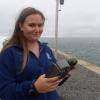Support Amazon turtle project
4 March 2024 12:31pm
MIT's Solve Global Challenges 2024
4 March 2024 11:26am
Conservation Science Fellow (Giraffe Conservation Foundation)
4 March 2024 11:18am
Firetail - updated price model from 03/2024
4 March 2024 11:06am
Project71: A Venture Competition for Ocean Regeneration
4 March 2024 10:49am
Useful Pi Script for Backing Up
1 March 2024 6:34pm
Species ID Needs?
19 February 2024 7:55pm
1 March 2024 2:27am
Hi Scott, thanks so much for sharing your thoughts here! It would be great to learn more about this, would you be interested in finding a time to chat? Thanks!
Machine Learning Postdoc Position, Understory
29 February 2024 11:56pm
WILDLABS Awards - Ask your questions!
7 December 2023 4:07pm
18 February 2024 1:37pm
So, if we haven't been contacted, means no award, right:)?
19 February 2024 3:16pm
Good question, I'd like to know the answer as well. I'm inclined to think that it does mean what you say, but I could be wrong and it's still a couple of weeks away till March :)
To clarify. The answer could affect plans I have for the short term. However, I can also understand a decision that wants to hold the tension right up to the announcement 😀 For myself I’d guess that it’s 99.9999% likely that it’s like you say. I really couldn’t imagine it being any other way.
29 February 2024 10:52am
Hi Kevin and Kim,
Apologies for the delayed response; however, we were unable to provide specific information until today. We aim to reach out to each applicant in the upcoming weeks or months.
All the best,
Data data everywhere, but not a byte to use!
29 February 2024 7:13am
Canopy Camera Trap for Indonesian Lizards
27 February 2024 9:20pm
28 February 2024 1:18pm
Hi Andrew! Great to hear your friend, Scott working in Indonesia! I bet he is working on east region with lot of cool monitor lizards!
I use Mavic 2 as well for my crocodile research in place with dense canopy and yes it was tricky! I would suggest to try DJI Avata may be better to do this task. Or maybe try equip propeller guard on the Mavic?
Would be it possible for the drone setting up the rope and after that the camera lift up using rope and slap to your desire place? just an idea, but in OZ they use drone carrying long rope to caught the crocodile, when it caught, the drone will release the rope and shift to people to work.
Calculating Wingbeat Frequency From Accelerometer Data
19 February 2024 9:07pm
27 February 2024 8:28pm
Great suggestion! Diving bird studies and their analyses are actually what has helped me get thus far with solving this problem. They happen to have done quite the same thing as I'm trying to do, just with more behaviors added. I believe the study was done with murres and kittiwakes.
Best,
Travis
27 February 2024 8:48pm
I'm very close to solving the problem. Just waiting for a function to run on a fairly large dataset to see the results. I will share the repository link with you when it gets accomplished!
The species I'm working with roost atop cave ceiling as also drop from there to get airborne!
Yes, they are triaxial (Technosmart) and body mounted right on their backs.
So far, I have created thresholds for different metrics derived from the accelerometer data. Essentially, I sectioned out a bunch of ACC data where I am positive flight is occurring, and did the exact same with roosting, and crawling around/scratching(activity while roosting). From there, I plotted the distribution of all the metrics to see which metrics have unique distributions that were significantly different than roosting/activity.
Using those distributions, I created thresholds for the important metrics in which all flight behavior was either above or below a certain value for that metric. This got me to being able to construct a decision tree based on these metrics which had pretty solid accuracy.
The downside is a small chunk of flight from the beginning and end of flight bouts are not being included in the behavior classification. I noticed that their wbf during those small chunk are indicative of flight and am going to try and add wbf as the last decision on the tree to improve the accuracy of it.
VeDBA is also being included and calculated and based on the values for the thresholds I have created for flight it should not matter how high their head is, rather how low it is, when x y and z thresholds are also met. If that makes sense.
Hope I answered most of your questions!
27 February 2024 8:59pm
Were you ever able to solve the problem? Interestingly enough, I begin a seal bio-logging study next year!
Also, you are correct. The errors were occurring during short bout flights as well as some spectral leakage, but I may have solved the problem by lower the window size. I've also corrected for the spectral leakage by creating a separate function that identifies any significant changes in calculated WBF that last < 2 seconds, then counts number of heave amplitudes within 1 second. I'm using an fft for the calculations and am just waiting for a function to run on a larger dataset to see if everything came out the way I am hoping for. Fingers crossed.
Best,
Travis
A Sensor-Based Approach to Studying Animal Behavior in Light Pollution Research
24 February 2024 9:33pm
27 February 2024 12:38pm
Thanks for helping me!
For now, I'll be testing with mains power (220V). The final prototype needs to be functional using solar panel.
The main system will be a Raspberry Pi, as the Brain of this project, receiving and storage all the measurements from the other devices, controlling the system. The measurement devices will be a microcontroller (still searching for which one to use) with differents sensor, such Lux sensor like TSL2561 or 2591, AudioMoth to record animals sounds, temperature and some other measurements.
For synchronization, must be effective, because the measurements must be or have the same time, so the storage data from differents devices can be grouped by it's timestamp and have full control for animals and fauna. So, probably it will be a lot of data per day.
The distance between each devices I haven't study yet, consider 20 meters within each device.
27 February 2024 1:49pm
Beware that the AudioMoth in itself will drift. It can be hooked up with a GPS to allow for GPS time synchronization, though.
https://www.openacousticdevices.info/gps-sync
27 February 2024 3:11pm
Unless you are planning on making a mesh network between nodes then the total distance spanning the location of all the nodes is important to know, not just the intra node distance.
If you have a Raspberry Pi as a main master node then you could install my sbts-aru project as a base project and you would get a sub-microsecond master time base by default as well as the GPS synchronizes the main system time with typically less than 0.1 microsecond, and SD card corruption resilience due to the in-memory overlayFS architecture.
If the total distance was 20m across all nodes, then the approach above could also combined the audio gathering capability as the sbts-aru project does audio logging as it would be within 20m of an audiomoth anyway, then you also have time-synchonized audio. If the distance is spanning 100m for example and it's just the intranode distance that is 20m then everything is somewhat different with respect to synchronization.
A PHD POSITION AT NOTTINGHAM TRENT UNIVERSITY
27 February 2024 9:42am
Engineer in novel technologies and approaches for biodiversity monitoring
26 February 2024 6:12pm
WILDLABS Awards 2024 - Statistics
15 January 2024 5:24pm
14 February 2024 3:29pm
Gender representation in WILDLABS Awards 2024
@alexrood and I dived into WILDLABS Awards data to study women representation.
Here are the results and some of them are really compelling:
26 February 2024 5:03pm
Check out this breakdown of how the WILDLABS Awards 2024 applicants were using tech to address different conservation issues. Special thanks to @Adrien_Pajot for gathering the data!
26 February 2024 5:25pm
Thanks @alexrood for creating this visual!
Needing help from the community: Bioacoustics survey
14 February 2024 9:46am
24 February 2024 7:23pm
Was great to chat with you Sofia and I would encourage others in the Acoustics community to help provide input for Sofia's study!
26 February 2024 8:57am
Thank you so much for your encouraging words! I'm thrilled to hear that you enjoyed our conversation, and I truly appreciate your support in spreading the word about my survey within the Acoustics community. Input from individuals like yourself is incredibly valuable to my study, and I'm eager to gather as much insight as possible. If you know of anyone else who might be interested in participating, please feel free to share the survey link with them. Once again, thank you for your support—it means a lot to me!
Best regards,
Sofia
Voice activated recording devices on satellite collars
18 February 2024 7:01am
24 February 2024 8:38am
I am sure Simon can chime in with exact specifications. I do not have it with me now. The centre distance between the attachment holes at each in end is 20mm wich will fit the standard holes in a collar from Vectronics Aerospace.
Simon posted images of the logger attached to a collar on a spotted Hyeana here: https://twitter.com/chamaillejammes/status/1441657479612542990
To-do now done in South Africa:
— Simon Chamaillé (@chamaillejammes) September 25, 2021
☑️ Being ridiculously proud of achieving data transfer over local GSM and LoRa networks for tracker
☑️ Being ridiculously proud of the way our wehear logger fits on lions and hyaenas. Looking forward to listening to their life. pic.twitter.com/CvgvovVjOp
25 February 2024 9:31am
We are studying muskoxen which are exposed to a polar night of between 3-4 month where the sun does not come over the horizon. On the other hand it also means that it will be continously OVER the horizon during the 3-4 summer months.
We are keeping an eye out for kinetic energy harvesting and there has been some interesting progress recently:
https://journals.plos.org/plosone/article?id=10.1371/journal.pone.0285930
@M_Stanton , you provide a nice list of uses of animal borne audio. We could add environmental sounds both abiotic and biotic.
We would LOVE to use audio more for ground truthing behavioural states and we would LOVE if the audio recordings could be GPS time synced...
@jared , it sounds interesting with the mentioned increased capabilities of the Iridium system. Can you link to any references for that?
Cheers,
Lars
26 February 2024 12:43am
I heard it through industry chatter but can't find a news release on it yet.
Timelapse Infrared Camera Suggestions
14 February 2024 1:54am
24 February 2024 6:18am
I doubt there is an off the shelf solution. Likely you will have to build one. Again I think the FLIR leptons could be of value here.
@krasi_georgiev you have worked with Leptons before ? Is this something you are able to advise on ?
25 February 2024 1:11pm
Ah yes. I didn’t notice that. Indeed it’s “near infrared”, 850nm lighting.
Camera Traps batteries waste
11 December 2023 5:49am
16 February 2024 2:47am
Thanks for the update @Frank_van_der_Most . I have been curious about the AA Li-Ion/Li-Po batteries and how they perform. The sudden drop in reported voltage will likely be from the internal voltage regulator switching off when the internal cell gets to the low voltage threshold (usually around 3V) to avoid damage to the cell. Looking now at a discharge curve they show a constant 1.5V, then a step down to 1.1V before dropping to zero. I don't know how you can possibly test these externally to know how much energy they have left until you hit the 1.1V step.
18 February 2024 8:28pm
Hi Alistair @alsnothome , see the comments of @Amanda_Matthes at the post here. Basically, it is not easy
23 February 2024 11:11pm
I've used AA rechargeable almost exclusively for many years now. I try to get rechargeables sourced from Japan (Panasonic Eneloop and Fujitsu), but have also used Eveready and EBL. I've used them in Reconyx, Scoutguard, Loreda and other low end cameras. One option you could try if it's in your budget is the solar powered camera traps. You need one set of rechargeables when you first deploy them but don't need to change the batteries afterwards. I'm trialling the Gardepro model that a local supplier sells. I intend to deploy them high up in trees to monitor nest boxes and tree hollows, so regular access to change batteries and SD cards was going to be difficult.
Insect vibrational communication on AudioMoths
23 February 2024 4:16pm
International Day of Forest 2024 Webinar: Forest & Innovation
22 February 2024 2:00pm
SMART Global Congress 2024
22 February 2024 11:00am
WILDLABS Washington DC Meet-Up
21 February 2024 7:33pm
WILDLABS NYC Networking Event
21 February 2024 7:27pm
22 February 2024 1:40pm
SMART Partnership Director
21 February 2024 4:32pm
Senior Software Engineer, Skylight
21 February 2024 3:44pm
Technical Field Officer
21 February 2024 3:40pm
Scaling biodiversity scoring for supply chains aligned with TNFD
20 February 2024 9:44am























23 February 2024 2:10pm
Hello Nadia,
A forensic genetic challenge exists when DNA is destroyed by processes used in manufacturing of derivative animal products, preventing law enforcement in identification of protected species. Alternative methods such as lipid profiles or isotope analysis unique to certain species may be possible but require voucher specimens that may or may not be available and methods that have not been tested or peer reviewed. Examples below:
This is a law enforcement issue and would like to discuss possible solutions.